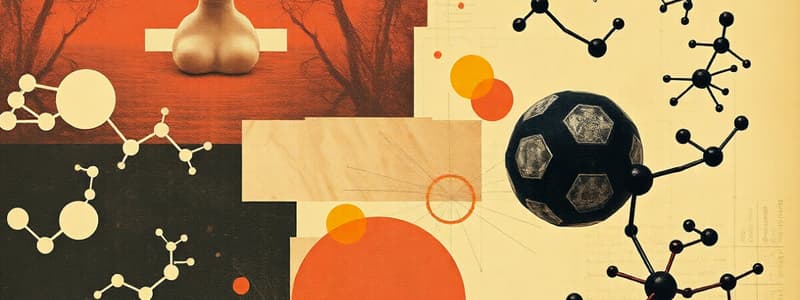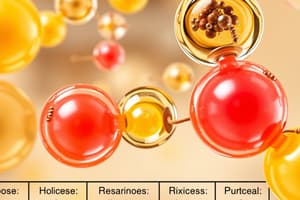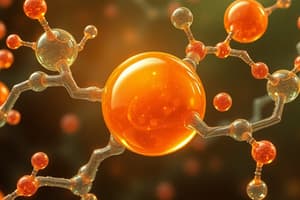Podcast
Questions and Answers
How many ATP molecules are effectively used during the activation phase of fatty acid oxidation?
How many ATP molecules are effectively used during the activation phase of fatty acid oxidation?
- 3
- 4
- 2 (correct)
- 1
During β-oxidation of a saturated fatty acid with 16 carbons, how many molecules of Acetyl-CoA are produced?
During β-oxidation of a saturated fatty acid with 16 carbons, how many molecules of Acetyl-CoA are produced?
- 6
- 9
- 8 (correct)
- 7
What is the key difference in the products of β-oxidation between a fatty acid with an even number of carbons, such as palmitic acid, and one with an odd number of carbons, such as margaric acid?
What is the key difference in the products of β-oxidation between a fatty acid with an even number of carbons, such as palmitic acid, and one with an odd number of carbons, such as margaric acid?
- Both even and odd numbered fatty acids produce Acetyl-CoA and succinyl-CoA, the difference is in the amount produced
- Even numbered fatty acids produce propionyl-CoA, while odd numbered fatty acids produce Acetyl-CoA
- Odd numbered fatty acids produce propionyl-CoA in the last step, which is then converted to succinyl-CoA (correct)
- Even numbered fatty acids produce an additional carbon molecule
In fatty acid synthesis, what 2 key compounds serve as starting materials?
In fatty acid synthesis, what 2 key compounds serve as starting materials?
How many steps of β-oxidation are needed to fully oxidize a 17 carbon fatty acid?
How many steps of β-oxidation are needed to fully oxidize a 17 carbon fatty acid?
Which of the following is a primary function of bile salts in lipid digestion?
Which of the following is a primary function of bile salts in lipid digestion?
During lipid digestion, which enzyme is secreted in the mouth to initiate the breakdown of fats?
During lipid digestion, which enzyme is secreted in the mouth to initiate the breakdown of fats?
What are the primary products of lipase digestion that are absorbed by intestinal cells?
What are the primary products of lipase digestion that are absorbed by intestinal cells?
After absorption into intestinal cells, how are triacylglycerols transported in the body?
After absorption into intestinal cells, how are triacylglycerols transported in the body?
Which of the following best describes the function of lipoproteins?
Which of the following best describes the function of lipoproteins?
During fatty acid oxidation, what compound is formed from fatty acids with an even number of carbon atoms?
During fatty acid oxidation, what compound is formed from fatty acids with an even number of carbon atoms?
What is the function of carnitine in the process of lipid catabolism?
What is the function of carnitine in the process of lipid catabolism?
Which of the following is a key step involved in lipid catabolism?
Which of the following is a key step involved in lipid catabolism?
What characteristic defines lipids as a group?
What characteristic defines lipids as a group?
Which of the following is NOT a primary function of lipids in biological systems?
Which of the following is NOT a primary function of lipids in biological systems?
Which of the following lipid types includes a glycerol backbone?
Which of the following lipid types includes a glycerol backbone?
What is the primary role of triacylglycerols (TAGs) in the body?
What is the primary role of triacylglycerols (TAGs) in the body?
In a fatty acid, what does the 'ω' designation indicate?
In a fatty acid, what does the 'ω' designation indicate?
What is the correct term for a molecule consisting of a glycerol molecule with two fatty acids attached?
What is the correct term for a molecule consisting of a glycerol molecule with two fatty acids attached?
Which of the following best describes the structure of a phospholipid?
Which of the following best describes the structure of a phospholipid?
What is the key difference between glycerophospholipids and other types of lipids?
What is the key difference between glycerophospholipids and other types of lipids?
Flashcards
Lipids
Lipids
Large and diverse group of organic compounds characterized by their insolubility in water and high solubility in organic solvents. They are essential components of living organisms.
Fatty Acids
Fatty Acids
Long, unbranched hydrocarbon chains with a carboxylic acid group at one end.
Glycerol
Glycerol
A three-carbon alcohol molecule that forms the backbone of many lipids, particularly triacylglycerols.
Triacylglycerols
Triacylglycerols
Signup and view all the flashcards
Phospholipids
Phospholipids
Signup and view all the flashcards
Steroids
Steroids
Signup and view all the flashcards
Beta Oxidation
Beta Oxidation
Signup and view all the flashcards
Fatty Acid Synthesis
Fatty Acid Synthesis
Signup and view all the flashcards
Fatty Acid Oxidation
Fatty Acid Oxidation
Signup and view all the flashcards
Activation (Fatty Acid Oxidation)
Activation (Fatty Acid Oxidation)
Signup and view all the flashcards
Acetyl CoA Transport (Fatty Acid Synthesis)
Acetyl CoA Transport (Fatty Acid Synthesis)
Signup and view all the flashcards
What are Sphingolipids?
What are Sphingolipids?
Signup and view all the flashcards
What are Glycolipids?
What are Glycolipids?
Signup and view all the flashcards
Describe Steroids
Describe Steroids
Signup and view all the flashcards
What are Steroid Hormones?
What are Steroid Hormones?
Signup and view all the flashcards
Explain Lipid Digestion
Explain Lipid Digestion
Signup and view all the flashcards
What are the products of Lipid Digestion?
What are the products of Lipid Digestion?
Signup and view all the flashcards
What are Lipoproteins?
What are Lipoproteins?
Signup and view all the flashcards
What is Lipid Catabolism?
What is Lipid Catabolism?
Signup and view all the flashcards
Study Notes
Lipids
- Lipids are water-insoluble (hydrophobic) molecules, highly soluble in organic solvents.
- They have both hydrophilic (polar) and hydrophobic (non-polar) sides.
- Lipids have diverse roles including energy storage, membrane structure, and signaling.
Learning Objectives
- Explain structural properties of lipids
- Explain the roles of lipids
- Classify lipids (e.g., fatty acids, phospholipids, steroids, waxes, sphingolipids, triacylglycerides, terpenes, eicosanoids, ceramides)
- Recognize fatty acids
- Explain lipid digestion and absorption
- Recognize steroids
- Classify lipoproteins
- Explain fatty acid catabolism (beta oxidation)
- Explain fatty acid synthesis
Types of Lipids
- Fatty acids
- Waxes
- Sphingolipids
- Phospholipids
- Steroids
- Triacylglycerides
- Ceramides
- Terpenes
- Eicosanoids
Important Lipids
- Free Fatty Acids
- Triacylglycerols
- Phospholipids
- Glycolipids
- Steroids
Lipid Digestion
- Digestion begins in the mouth (chewing, saliva) and continues in the stomach (gastric lipase) and intestine (pancreatic lipase).
- Bile salts help emulsify fats. This breaks down large fat globules into smaller droplets.
- Peristalsis is the mechanical mixing of food
- Bile salts reduce surface tension, enabling better mixing and digestion.
- Fatty acids, glycerol and other small molecules are produced.
Absorption
- Products of lipase digestion (fatty acids, 2-monoacylglycerol, cholesterol) form micelles.
- Micelles pass through cell membranes.
- Fat soluble vitamins (A, D, E, K) are absorbed directly alongside.
- Bile salts are absorbed in the terminal ileum (most are reabsorbed).
Transport
- Reassembled into triacylglycerols and incorporated into chylomicrons.
- Chylomicrons enter lymphatic system.
- Lipoproteins transport lipids in the blood. Types include chylomicrons, VLDL, LDL, and HDL.
Lipoproteins
- Chylomicrons: Transport dietary lipids from intestine to the tissue
- Very low-density lipoproteins (VLDL): Transport lipids from the liver to tissues.
- Low-density lipoproteins (LDL): Transport cholesterol from the liver to tissues.
- High-density lipoproteins (HDL): Remove excess cholesterol from tissues and return it to the liver for excretion.
Lipoprotein Structure
- Outer coat: Contains proteins (apoproteins), phospholipids, and some cholesterol.
- Inner core: Contains triacylglycerols and cholesteryl esters.
Fatty Acid Oxidation
- Fatty acids are activated by the addition of CoA.
- Transported into mitochondria via carnitine shuttle.
- Beta oxidation is a repetitive process where two-carbon units are successively cleaved from the fatty acid chain.
- Each cycle produces one acetyl-CoA, one FADH2, and one NADH.
- The acetyl-CoA enters the citric acid cycle.
Fatty Acid Synthesis
- Occurs in the cytoplasm.
- Uses acetyl-CoA and NADPH.
- Three main stages:
- Acetyl CoA transport
- Malonyl CoA synthesis
- Elongation of fatty acid chain.
- Essential fatty acids need to be supplied from the diet
Lipid Catabolism and Synthesis
- Glycolysis yields acetyl CoA.
- Acetyl CoA is precursor for fatty acid synthesis and oxidation.
Studying That Suits You
Use AI to generate personalized quizzes and flashcards to suit your learning preferences.




